AOC i2353Ph - IPS for a nice, low price
by Chris Heinonen on January 30, 2012 12:40 AM ESTCalibration and Results
Of course, once we use ColorEyes Display Pro to calibrate the AOC, we would expect even better results than we got out of the box. As usual, we set a white point target of D65, a gamma of 2.2, minimum black level, and a white level of 200 nits. I then checked the quality of the calibration using the Gretag Macbeth color checker chart. Often you will see display reviews that use the calibration target points to see the quality of the calibration. That gives you a good indicator of how well the software and hardware was able to hit those targets, but unfortunately no idea if only those targets improved, or if other colors were improved as well. Using the Gretag Macbeth swatches, which are designed to mimic common colors in the real world, gives you a better idea of the overall quality of the calibration instead of the quality of those specific targets.
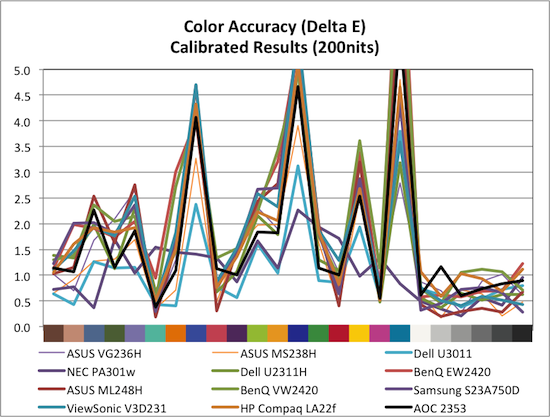
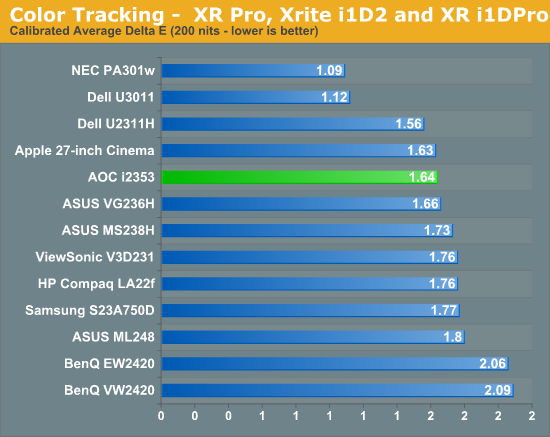
Here we see that the AOC calibrated down to an average dE of 1.64, which is pretty common. When I looked at the results some more, I got a little curious and also decided to see what the median color error was for all the displays. The Gretag Macbeth color checker includes some shades of blue that are at the very edge of the sRGB colorspace, or totally out of it in the case of one sample. In these cases if the display can’t reproduce those shades, the average dE for it might be thrown way off, but the median dE could still be very low since it does a very good job with the colors it can reproduce.
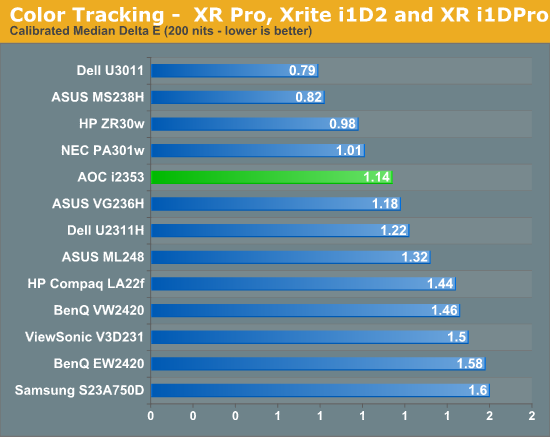
Looking at the results, we can see that the AOC has a much lower median dE than some monitors that produce a lower average dE. When we get to the color gamut data later in the review, we will see that the AOC has a smaller than average gamut, which is leading it to have larger than average errors for color samples on the edge of the sRGB colorspace. In effect, the conclusion we can pull from this is that the AOC can’t produce as many colors as other reviewed displays, but for those that it can produce it does so more accurately. Results like this are why you can’t just look at a lower dE and assume that a display will automatically be better than another display with a higher dE, as it’s just a single number that only tells part of the story.
For people that might use the AOC for press work, or prefer a dimmer display in a dark room like myself, I also calibrated the display to 100 nits of brightness and then took another set of readings.
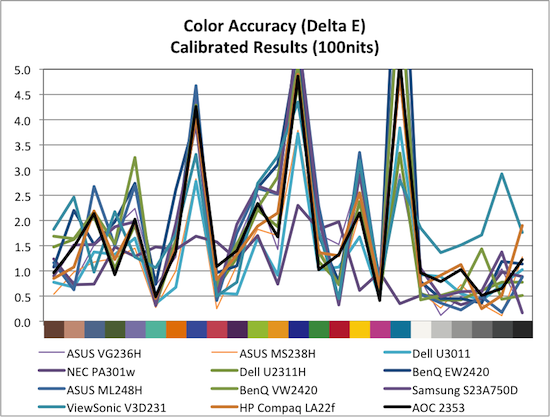
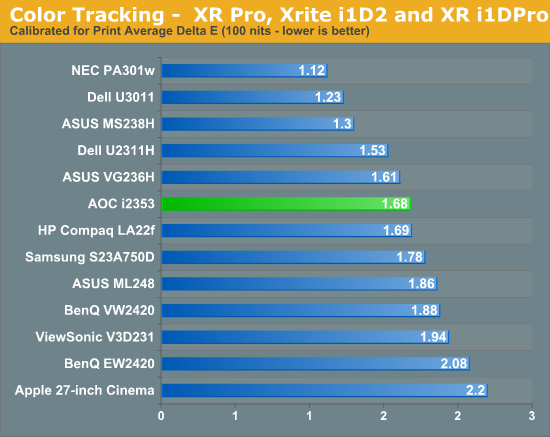
The numbers for 100 nits are almost identical to those for 200 nits. The grayscale is good, and the large errors are all contained in shades of blue, as we would expect.










71 Comments
View All Comments
imaheadcase - Monday, January 30, 2012 - link
NOPEkmmatney - Monday, January 30, 2012 - link
Seriously. I would happily pay $100 more for this same display as a 24" monitor, with 1920 x 1200 resolution.piroroadkill - Monday, January 30, 2012 - link
So, you want a Dell U2412M then?Alexo - Monday, January 30, 2012 - link
Hi Chris,You wrote:
> I’ve been using a Dell FPW2005 IPS display for years now
How does this monitor compare to your FPW2005 (or to the larger 2209WA)?
cheinonen - Monday, January 30, 2012 - link
The Dell has more input lag, lower resolution, and no HDMI inputs or speakers, but has a very nice, adjustable stand which I like on my desktop (I can put it high enough to get over my speakers), as well as the ability to rotate to portrait mode for document editing. I didn't do a head-to-head as I'm finding the resolution on the Dell to be very limiting at this point, and would much prefer a 27" or 30" display for my desktop. I would have been fine with replacing the Dell with the AOC for a general purpose display, as for photo editing I have a different display I use, and I have a 24" Sony CRT sitting here for hard core gaming if I need no lag.anactoraaron - Monday, January 30, 2012 - link
I would love to see you guys review this eIPS panel. I know you are limited to what you are given to review, but I have been checking this one out for awhile now.mr2kat - Monday, January 30, 2012 - link
My mainstay monitor is the Dell 2408 although I have a couple of IPS monitors (U2310) which are calibrated for photo-edit work. The AOC i2353 is a great buy at the price-point. The base can be wall mounted (there are locating holes in the base) however the base contains the controls and power supply connector, so you can't omit the base altogether.The lack of vertical adjustment means that for most usages you will need a shelf or a couple of phone directories to elevate the monitors to an ergonomic height. I also note the front bezel on the monitors is flimsy and has rippled slightly so there is a gap between bezel and the display.
When I'm working on documents I like to rotate the Dell monitors. Of course the AOC has no rotate function but with the narrower monitor a rotate isn't as effective as with the Dell. I also note the AOC does not have a DVI-D to HDMI cable included in the box (when will people stop shipping stupid SVGA cables?).
Gaming? I play Portal 2 and Serious Sam III and I don't have a problem with lag - but I'm old, so younger people might see this as a problem.
This monitor needed calibration because out of the box it was blue biased. Once calibrated the results were excellent - I use the monitors for web design and video. I also found that some computers (about 30%) really needed the profile loaded from the AOC disk in order to properly setup the display.
I had never heard of AOC before this monitor, however I am suitably impressed. The power brick runs, at most, just mildly warm to the touch regardless of usage. So I will be buying more of these.
Sabresiberian - Monday, January 30, 2012 - link
Thanks so much for reviewing an AOC product, especially this one.You see AOC products listed often by etailers, and their price is attractive but I'm guessing most people are like me and shy away from them because, well, "cheap is cheap". Sometimes, though, it's not cheap, it's inexpensive, and that appears to be the case here.
A very nice find!
;)
jaydee - Monday, January 30, 2012 - link
If I recall correctly, AOC had a pretty well regarded CRT business back 10-15 years ago, so I've always associated them with quality, though up until now their LCD's were a bit of an unknown to me.annnonymouscoward - Monday, January 30, 2012 - link
"IPS has never been the first choice for people when it comes to gaming due to slower reponse times than a TN display" - I think the 60Hz limitation, which applies for IPS and TN, is the primary limiting factor. GTG is 8ms vs 2ms, while new frames come every 16.7ms."The lag is a little bit too high for hard core gamers" - 1 frame is arguably tolerable even for the hardcore. And if it's not acceptable for someone, then I'd say the only thing acceptable for that person is a CRT at >80Hz.
-1 for 16:9. :P
btw I had to register a new account with "annnonymouscoward" instead of "annonymouscoward", since anandtech spontaneously decided I'm a spammer.